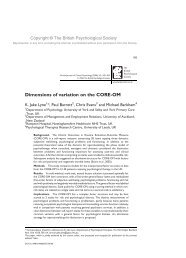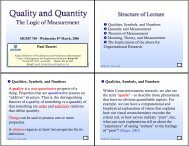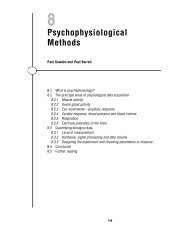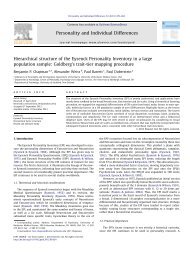Counselling Psychology Review - Paul Barrett
Counselling Psychology Review - Paul Barrett
Counselling Psychology Review - Paul Barrett
Create successful ePaper yourself
Turn your PDF publications into a flip-book with our unique Google optimized e-Paper software.
Dr Miodrag Popovic, Dr D. Milne & Professor P. <strong>Barrett</strong><br />
Methods of evaluating, monitoring and<br />
improving the quality of services<br />
Evaluations of service delivery vary in their<br />
complexity, expense, inclusiveness, specificity<br />
and representativeness. For example,<br />
Parry (1992) specifies service evaluation,<br />
operational research, quality assurance, total<br />
quality management, audit (service, professional<br />
or medical), and their combinations.<br />
Lavender et al. (1994) distinguished between<br />
internal (led by internal standards and staff<br />
and disregardful of the wider picture) and<br />
external (led by more formal assessment and<br />
external staff and standards) reviews of<br />
services, both necessary. Internal review procedures<br />
include professional supervision,<br />
appraisal systems, audit, clinical review meetings,<br />
peer review, case discussion/presentations<br />
and quality circle. External review<br />
procedures include inspectorates/committees,<br />
programme evaluation based on outcome<br />
measures, standard-based approaches, individual<br />
case review and case management<br />
monitoring, organisational development<br />
consultancy, consumer representative on<br />
planning groups and service satisfaction<br />
surveys. Some of key issues associated with<br />
service evaluation are its difference from<br />
applied research, commissioning, ethics, a<br />
need for specific research methods or skills,<br />
‘multi-factor’ outcomes and a multidisciplinary<br />
approach, ensuring appropriate feedback,<br />
anticipation of changes, compatibility<br />
of monitoring and improvement (Turpin,<br />
1994; Lavender et al., 1994).<br />
Clients’ involvement varies, from establishing<br />
satisfaction and baselines to planning<br />
services and promoting effectiveness<br />
(College of Health, 1998). It also entails<br />
being involved formally (through committees)<br />
or informally (via the media), or as<br />
subjects of data collection. No final advantage<br />
was established between direct (‘How<br />
satisfied…’) or indirect questions (‘Did<br />
your therapist understand…’), interview or<br />
questionnaire, census or sample (Fitzpatrick,<br />
1992a, 1992b).<br />
In addition to current clients, some<br />
comprehensive approaches simultaneously<br />
gather information from past clients (e.g.<br />
continuously, on a monthly basis; Damkot et<br />
al., 1983), patients’ relatives/cares and relevant<br />
professionals (e.g. Ruggery & Dall’<br />
Agnola, 1993) or a person unconnected with<br />
the care of users (Trinder, Mitchell & Todd,<br />
1994). Specifically relating to psychotherapy<br />
outcome, Barkham et al. (1998) suggested<br />
the use of a routine, core and standardised<br />
battery (CORE). This involves clients’ preand<br />
post-therapy completion of a psychometric<br />
instrument which aims to assess their<br />
symptoms, distress, functioning and risk.<br />
Therapists are required to complete their<br />
pre- and post-therapy assessment forms<br />
related to their clients’ motivation, types of<br />
treatment, etc. However, this comprehensive<br />
assessment does not tap into clients’ views of<br />
their services and relevant engagement and<br />
satisfaction.<br />
Client satisfaction surveys<br />
Until the 1970s client satisfaction, defined as<br />
‘the extent to which treatment gratifies the<br />
wants, wishes, and desires of clients’ (Lebow,<br />
1982), was believed to be unrelated to<br />
service quality and outcome (Damkot,<br />
Pandiani & Gordon, 1983). However, having<br />
been introduced by health managers (Fitzpatrick,<br />
1992b), subsequently recommended<br />
by the government, well-accepted by users<br />
and promoted by professional bodies<br />
(College of Health, 1998), client satisfaction<br />
surveys have become linked to service<br />
quality, outcome (Damkot, Pandiani &<br />
Gordon, 1983; Parry, 1992; Cape, 1995), i.e.<br />
clinical effectiveness and service improvement<br />
(Dagnan & Fish, 1991) and thus<br />
clinical governance. Despite poor methodological<br />
bases (Stallard, 1996) and a<br />
frequent lack of explanations for what needs<br />
improving (Williams & Wilkinson, 1995),<br />
this influential (College of Health, 1998),<br />
external review procedure (Lavender et al.,<br />
1994) has become a systematically studied<br />
(Larsen, Attkisson, Hargreaves & Nguyen,<br />
1979; Stallard & Chadwick, 1991) and most<br />
commonly used method of reviewing<br />
services (Stallard, 1996).<br />
16 <strong>Counselling</strong> <strong>Psychology</strong> <strong>Review</strong>, Vol. 22, No. 2, May 2007












